Filling sketchbook pages can be a wild adventure with these 20 doodle ideas. Start with easy floral clusters and geometric shapes, then sketch goofy animal faces or scribble spirals for a burst of color. Try continuous line leaves, playful food drawings, or zentangle patterns that twist and turn. Doodle expressive faces, mix in quirky objects, and decorate with bullet journal icons or whacky moodboard collages. The best part? Each idea opens up a new way to make your sketchbook pop—there’s more inspiration ahead!
Key Takeaways
- Experiment with nature-inspired doodles like floral clusters, cacti, and playful plant pots for lively, textured sketchbook pages.
- Fill your sketchbook with geometric shapes, abstract patterns, and spontaneous doodles using lines, curves, and colorful textures.
- Try creative lettering, song or book cover styles, and project moodboards to add personality and structure to your sketchbook.
- Explore continuous line leaves, Zentangle patterns, and sketchnote techniques for visually engaging and meditative filler doodles.
- Add simple animal doodles, quirky creatures, and whimsical elements to create playful and charming visual interest throughout your pages.
Floral Clusters
There’s something super satisfying about sketching a bunch of flowers that seem to pop right off the page, and that’s where floral clusters really shine.
With just a marker pen, anyone can start by outlining simple flower shapes—using light colors means it’s easy to layer bolder shades on top. Petals drawn with bendy lines and spiral centers bring loads of energy to the design, and mixing up the sizes and placement of flowers makes the clusters look way more interesting.
Want more depth? Just grab another colored marker and layer away! Even empty spaces aren’t a problem—just doodle in some playful dots or dashes.
For artists who love experimenting, adding mixed media like colored pencils or stickers can make these floral clusters extra cool.
Colour Spirals
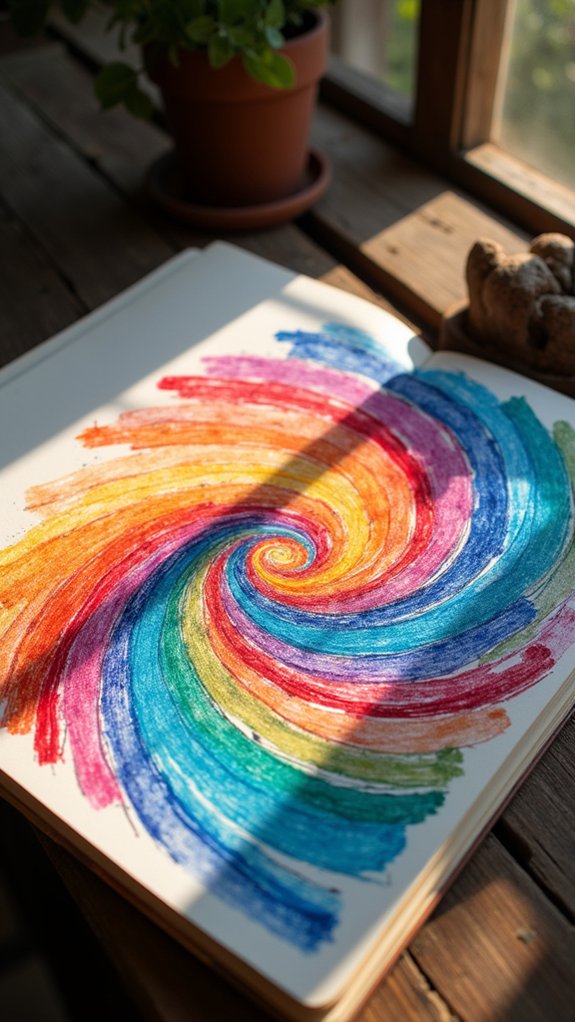
A splash of spirals can jazz up any sketchbook page, and colour spirals are basically the rockstars of the doodle world. To get started, pick four awesome colors.
Begin with the lightest shade—think of it as laying down the foundation of a cool band poster. Sketch out your spiral by drawing stick lines outward, but don’t cram them together. Leave enough space so you can fill the page with those colors!
Grab your second lightest color and slip it into the gaps, instantly adding some serious dimension. Stack on even darker shades, layering lines however your vibe tells you—curves, wiggles, zig-zags, you name it!
Experiment with color combinations, and just let your mind wander. No rules—just fun, vivid spirals bursting with personality.
Continuous Line-Leaves
Some doodles just have that extra wow factor, and continuous line-leaves totally steal the show in any sketchbook.
To get started, just let your pen wander in a jagged line, which acts like a branch ready for action. Then, let wobbly leaf shapes sprout off that branch. It’s okay if your lines aren’t perfect—quirkier is better!
Fill each leaf with repeated lines for texture, making your sketchbook page pop with bold detail. If you’re feeling daring, grab a second color and doodle even more leafy shapes to make everything come alive.
Play around with shading by pressing harder with a darker color here and there for a cool, three-dimensional look. Continuous line-leaves are simple, eye-catching, and seriously fun!
Geometric Shape Doodles
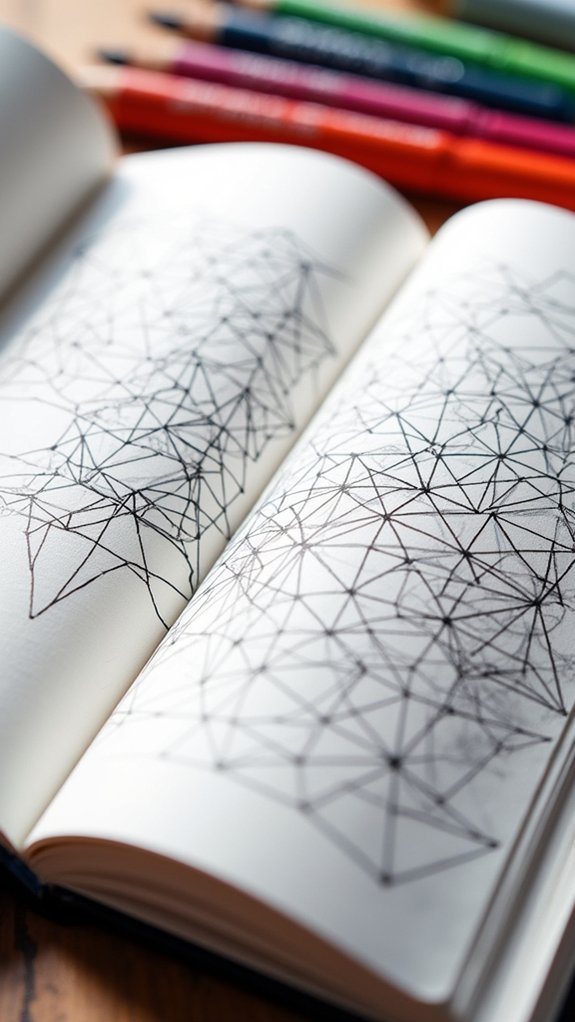
Staring at a blank page can feel like facing off with a boss battle, but starting with a simple circle or triangle quickly changes the mood.
Sketching easy shapes jumps over that first hurdle and opens up a world of experimenting with zentangle patterns, weird little squiggles, and all sorts of variations inside those lines.
With every new shape, geometric doodling starts to feel less like work and more like building your own awesome puzzle.
Breaking Blank Page Intimidation
Sometimes, that blank sketchbook page can feel like it’s staring right back, daring anyone to make the first move. It’s intimidating, right? The trick is to break the silence with something super simple—a geometric shape. Think circle, triangle, or maybe even a lopsided square if you’re feeling bold (don’t worry, nobody’s judging).
Once the first shape is down, it’s way easier to keep going. Next, start to doodle inside—add curves, dots, tinier shapes, or try layering patterns. Grab a ruler if you want crisp lines and show that blank page who’s boss!
Filling your shapes with different textures or crazy patterns keeps things interesting, and it’s almost impossible to mess up. Each little pattern breaks the intimidation, revealing new possibilities.
Exploring Zentangle Pattern Variations
Even if sketching can feel a bit nerve-wracking, diving into zentangle pattern variations flips that feeling on its head—it’s like a mini-adventure inside a geometric playground.
Imagine this: starting with a big, bold geometric shape—maybe a square or a circle—gives your doodle a strong foundation. From there, the magic happens as you fill that shape with smaller geometric patterns, repeating triangles, circles, and lines until your page starts to buzz with energy.
Mix up your line work—try straight, wavy, or even dotted lines to keep things interesting. Want your drawings to pop? Push a little harder or lighter on your pen for cool shading techniques, making some parts stand out while others fade back.
Toss in curves or spirals for good measure—balance achieved!
Everyday Object Sketches
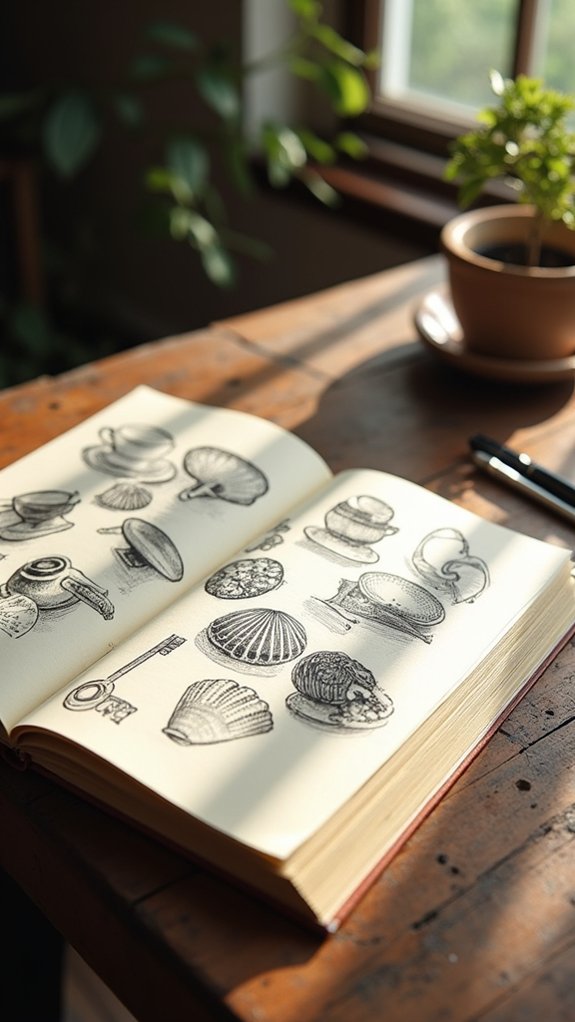
When it comes to sketching everyday objects, there’s a certain magic in turning something like a plain old coffee mug—or even a wobbly stack of books—into a doodle that totally pops off the page.
Everyday object sketches often start with basic geometric shapes: rectangles for books, ovals for cups, or circles for jars. It’s like building a blueprint before letting your creativity run wild.
Adding cool details, like a quirky mug handle or a funky jar label, makes each doodle stand out. Playing with line thickness and some clever shading creates depth, so even an ordinary light bulb looks epic.
Want even more flair? Personal touches or zany color choices turn classic objects into miniature masterpieces. Suddenly, that regular coffee cup seems pretty unforgettable!
Pattern Play
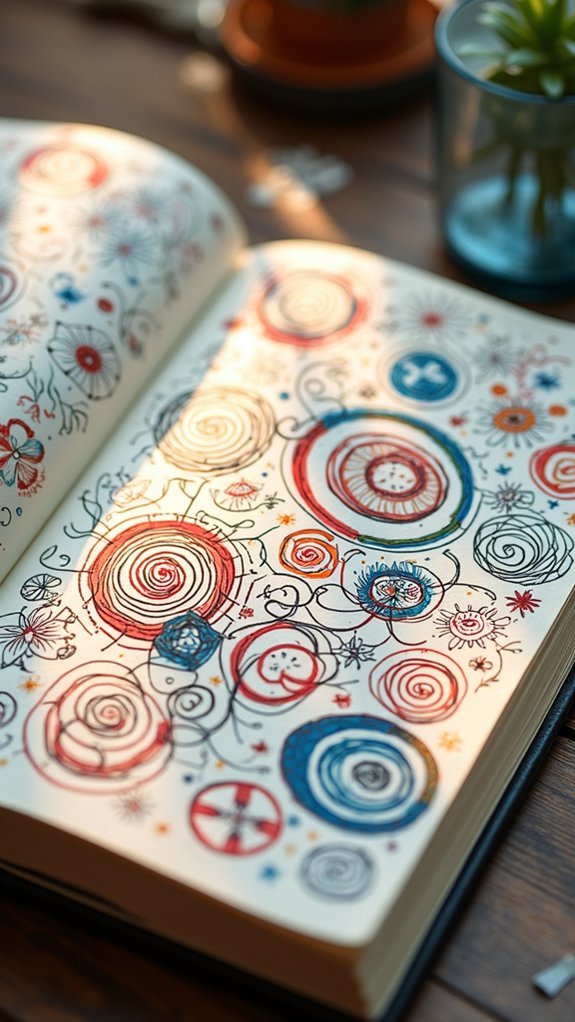
Sketching the world is cool, but there’s something wild about filling a page with patterns until it looks like a secret code or a maze you’d want to get lost in.
Patterns let doodlers turn empty spaces into hypnotic jungles of shapes, lines, and color. There’s real magic in the repetition—drawing those same lines or squiggles over and over is surprisingly relaxing. Some even say it’s as calming as listening to rain.
You can make patterns that are neat and tidy, or go full chaos mode with wild, unexpected shapes. The best part? There are no rules.
Try mixing things up to find your own style:
- Alternate stripes and dots.
- Layer geometric shapes for depth.
- Add splashes of color to electric-fy your doodles.
Moodboard Collage
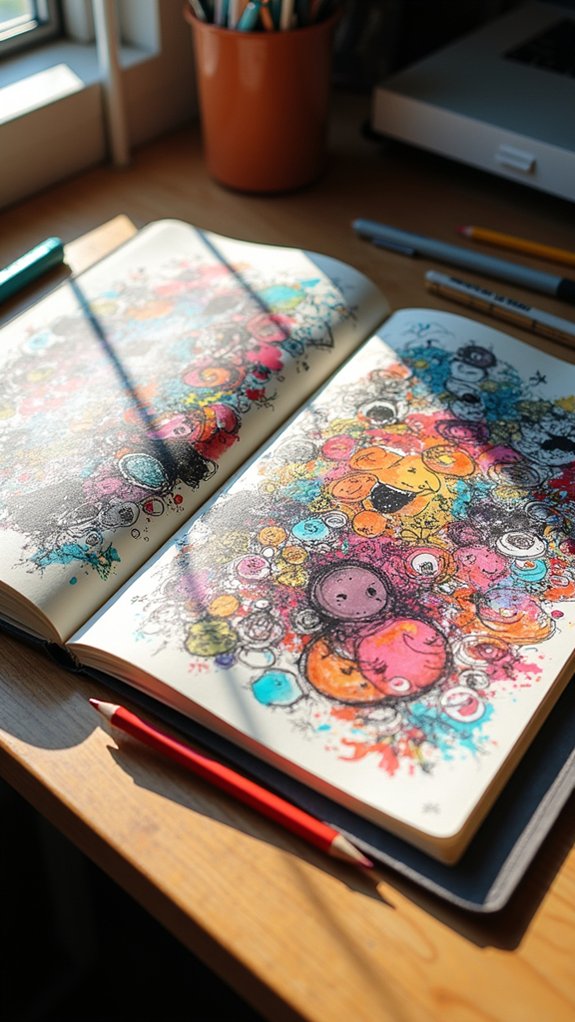
Moodboard collages are kind of like super-charged idea boards, pulling together anything that sparks excitement—magazine clippings, bold patterns, even that weird fabric scrap you found in your backpack.
Sorting through all these inspiring visuals and zeroing in on your favorite color schemes lets you set the mood of your project before you ever touch a brush or pencil.
It’s like creating the soundtrack and setting for your art—moodboard style—so every piece feels just right from the very start.
Gathering Inspiring Visuals
Even if someone’s brain feels messier than a spilled box of crayons, gathering inspiring visuals can turn that chaos into pure creative gold.
Building a moodboard is like snapping photos of all your favorite things and gluing them together in your sketchbook—not just for fun, but to spark wild, new ideas.
To make things easier, consider these three simple tips:
- Collect inspiring elements from magazines, online scrolling, or even random doodles—anything that grabs your eye.
- Mash up these treasures in your sketchbook; move them around or layer them, seeing what combos make the coolest vibe.
- Keep your moodboard close by, so when ideas feel stuck, you’ve got instant inspiration just a page-flip away.
Let inspiration explode, one page at a time!
Defining Color Schemes
While some artists love to wing it with color, building a moodboard collage is like giving your creativity a superpower cape. A moodboard lets you gather a mix of images, swatches, and cool color palettes all in one spot.
You can grab fabric samples, stickers, or printouts from your favorite magazines—whatever sparks your artistic spirit. Using a sketchbook for your moodboard makes it extra fun and messy; you’re free to move things around, rip out what doesn’t fit, and go wild experimenting before you pick your final look.
This process helps you figure out exactly which colors vibe well together. Plus, when your sketchbook starts filling up, your moodboard is always there as a trusty sidekick, keeping your colors and style on track.
Creating Project Atmosphere
Atmosphere is that invisible magic artists chase, and building a project moodboard is like catching lightning in a bottle.
A moodboard pulls in everything—cool images, wild textures, favorite quotes, and colors—mixing them up to capture the project’s unique vibe.
Think of your easy sketchbook as a safe spot for messy experiments. Don’t be shy about ripping, gluing, or doodling whatever strikes your fancy.
Want some ideas to help? Here you go:
- Snag magazine photos, movie stills, or fabric swatches to build your moodboard’s core.
- Play with washi tape, stickers, and markers to explore layouts and make things pop!
- Check your moodboard often and swap pieces out—keep your ideas fresh and your project’s atmosphere on point.
Moodboard magic? Totally possible.
Mixed Media Experiments
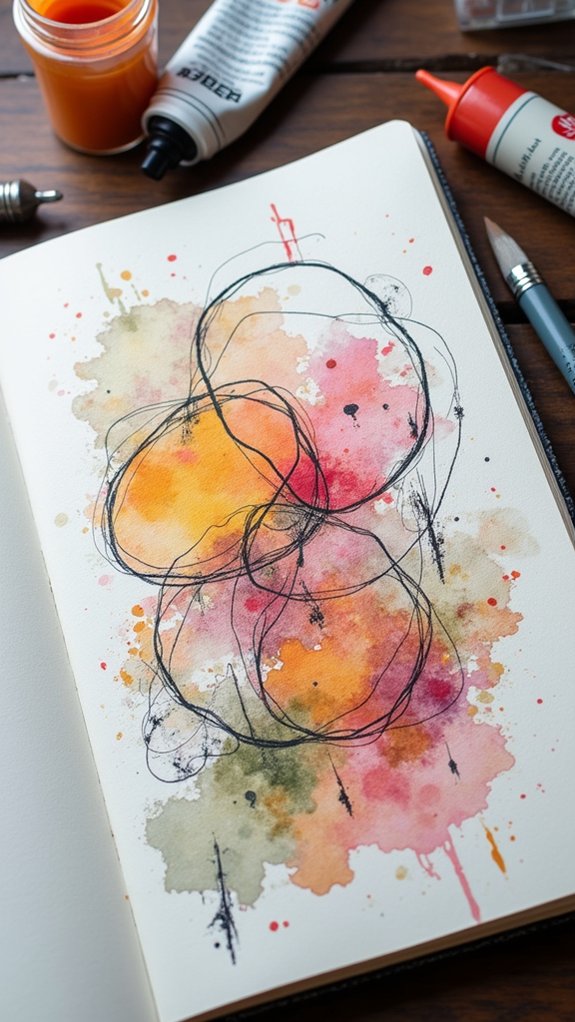
A whole world of creativity opens up when an artist experiments with mixed media in a sketchbook. Suddenly, there’s no need to choose just one art supply—why not combine markers, paint, and even magazine clippings?
Mixed media is all about mixing things up and seeing what happens. Thick sketchbook pages are a must; nobody wants their cool collage ending up as a sticky, soggy mess.
Using different materials gives each page amazing texture—imagine real leaves, tiny scraps of fabric, or layers of color packed together. It’s messy, exciting, and totally unpredictable.
Artists get to try wild new techniques, from wild layering to making tiny collage explosions. Each experiment brings something fresh, letting personalities and styles burst through in every sketchbook spread.
Simple Animal Doodles

Sketchbook magic happens when animal doodles start popping up on the page—suddenly, a circle turns into a chubby cat, and a squiggle transforms into a suspicious-looking octopus.
Drawing animals can be pretty simple if you start with some basic shapes. An oval shape makes a perfect head for a sleepy puppy or the body of a fat little whale.
If someone wants to make cute animal doodles, they can play with details—think floppy ears on bunnies or big cartoon eyes on owls. Remember, sketchbook animals don’t have to look perfect, and sometimes the silliest ones end up being everyone’s favorites.
- Use an oval shape for bodies and heads.
- Try heart wings and squiggly tentacles.
- Embrace quirky imperfections—they make doodles memorable!
Food-Themed Drawings

Food-themed drawings open up a world of fun, from sketching strawberries with leafy tops and tiny seeds to drawing goofy mugs for coffee or bubble tea—even when the mug handles look a little wild.
With desserts like peaches shaped like hearts or ice cream cones loaded with toppings, adding silly faces or polka dots turns every snack into a star.
There are clever ways to make even the simplest fruit, dessert, or snack doodle pop with personality, and sometimes imperfections just make things more fun.
Simple Fruit Sketch Ideas
Nothing livens up a blank page quite like diving into the world of fruit sketches—they’re colorful, fun, and surprisingly easy to start!
Simple fruit sketches can begin with just circles or ovals, making it super easy for anyone to try drawing favorites like apples, oranges, or even a cheeky peach. For those who want to step it up, experiment with colors to add depth—layer shades with markers or colored pencils to really make those fruits pop.
Adding fun touches like a goofy face or some shiny seeds turns an ordinary doodle into a mini masterpiece.
Here are three ways to make your simple fruit sketches totally stand out:
- Start with basic shapes—it keeps things easy.
- Experiment with colors for extra zing.
- Try drawing fruit combinations for creative scenes.
Playful Dessert Illustrations
After mastering those fruity doodles, it’s only natural to start craving something a little sweeter—like playful dessert illustrations that make every page feel like a party.
Imagine sketching lots of different types of treats: cupcakes with swirly frosting, ice cream cones stacked up high, and donuts covered in silly sprinkles. It all starts with basic shapes—circles, ovals, maybe a triangle or two.
Use a white gel pen to add highlights—think shiny cherries, glossy glaze, or glimmering sugar crystals. Mix things up by making a donut-cake hybrid or a cupcake with ice cream on top!
Go wild with colors; pastel pinks for cakes, bright yellows for lemons, or even funky blue for cartoon ice cream. Add cute faces, whiskers, or tiny hats to make one completely your own!
Quirky Snack Doodle Tips
Plenty of awesome snack doodles can jazz up any page in a sketchbook, especially when artists get creative with their shapes and details.
Drawing snacks is like inviting a little bit of fun to the page—think ice cream cones with big cheeks or grumpy cherries! Cute or silly faces on food make you feel like your doodle just said hello.
It’s important to always use simple shapes, so even tricky snacks become easy to draw.
- Start with basic shapes—a semi-circle for pizza or a squiggly line for spaghetti—that make the doodling process a little bit easier.
- Toss in expressions and tiny details, like strawberries with sparkly eyes or donuts with sprinkles exploding everywhere.
- Always use bold, vibrant colors to make every snack doodle pop off the page!
Nature-Inspired Elements

Nature always seems to have the best ideas when it comes to sketchbook doodles—just look outside, and inspiration is everywhere!
On one side of the page, I’m going to draw clusters of clouds, mushrooms, and crazy tall flowers, because why not? I’m using wiggly lines and oval leaves to make a big jungle of patterns—some stems twist around, others reach for the top, kind of like they’re in a race.
Throw in some strawberries or ice cream cones, and suddenly your nature doodle gets a fun, snacky twist. Want even more good vibes? Try pairing suns with rainbows.
Quick Mandalas
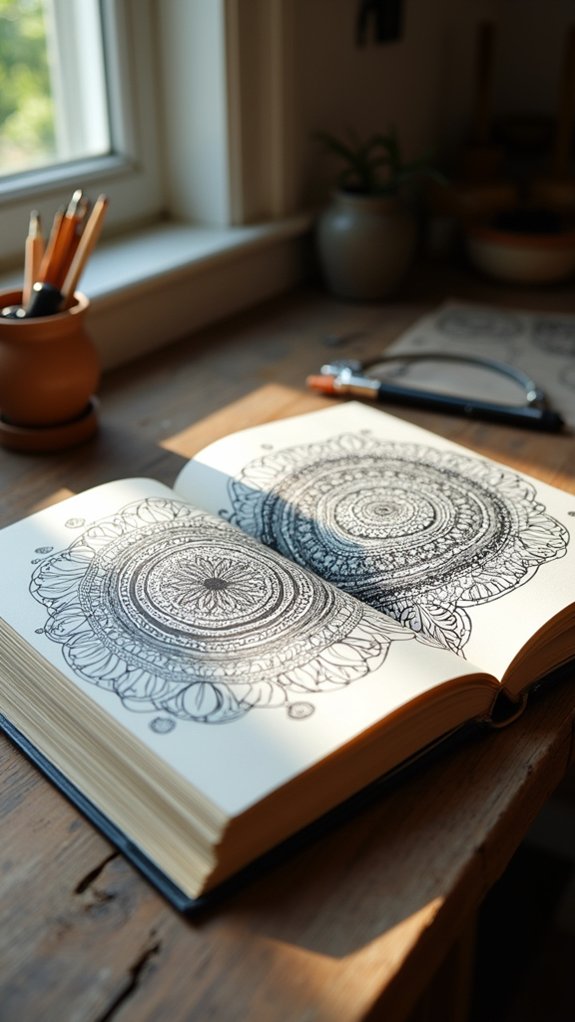
Some doodlers just can’t resist drawing quick mandalas—they’re like secret art superpowers for those moments when a sketchbook page feels way too empty.
Creating mandalas doesn’t require fancy mandala techniques or expensive supplies. Just start with a central dot and let geometric shapes—think circles, triangles, maybe a wonky square—burst outward in intricate symmetry.
Pattern exploration is where things really get fun; repetitive motifs inside each section add that next level of “wow.” Throw in some bright colors or wild shading to bring everything to life, and suddenly, mandalas feel almost magical.
Even better, as your pen moves with the rhythmic designs, it’s weirdly relaxing.
- Start from a center point for symmetry.
- Use geometric shapes for structure.
- Add patterns for depth and style.
Zentangle Patterns
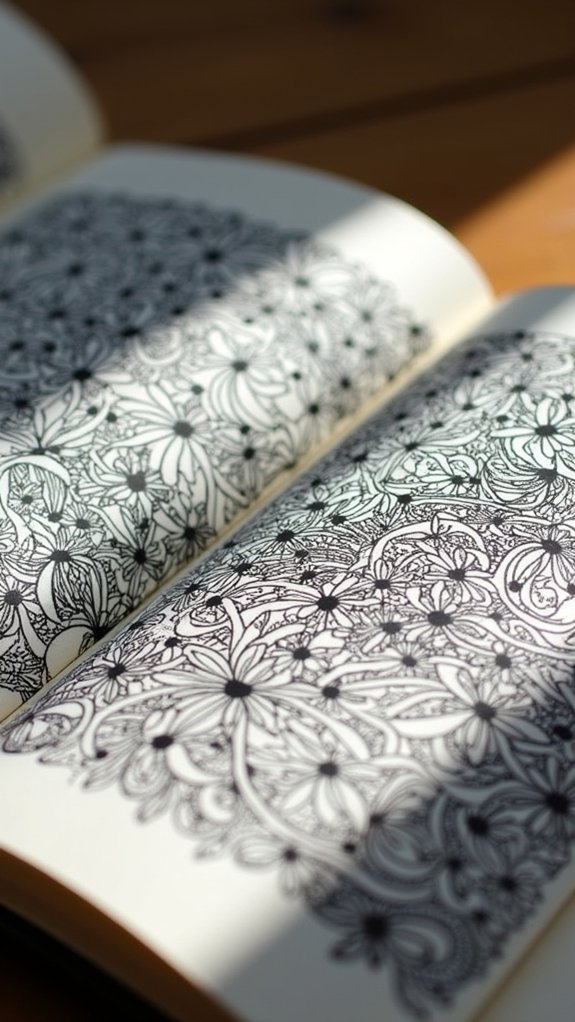
Zentangle patterns are a total game-changer for anyone who loves turning doodles into masterpieces. These intricate, structured designs use tangling techniques—like repeating lines, dots, or curves—to fill a space with seriously eye-catching detail.
The best part? Zentangle is all about mindful drawing, so it’s less about making something perfect and more about relaxing and letting your pen wander. Anyone can do it, no fancy art skills required.
Artists start with a simple shape, then plunge into pattern exploration, testing out all sorts of textures and lines. Soon enough, the page transforms into a mesmerizing maze of patterns!
Plus, Zentangle art looks awesome in sketchbooks or journals, turning any blank space into a cool visual adventure. Talk about doodling leveled up!
Succulent and Cacti Illustrations
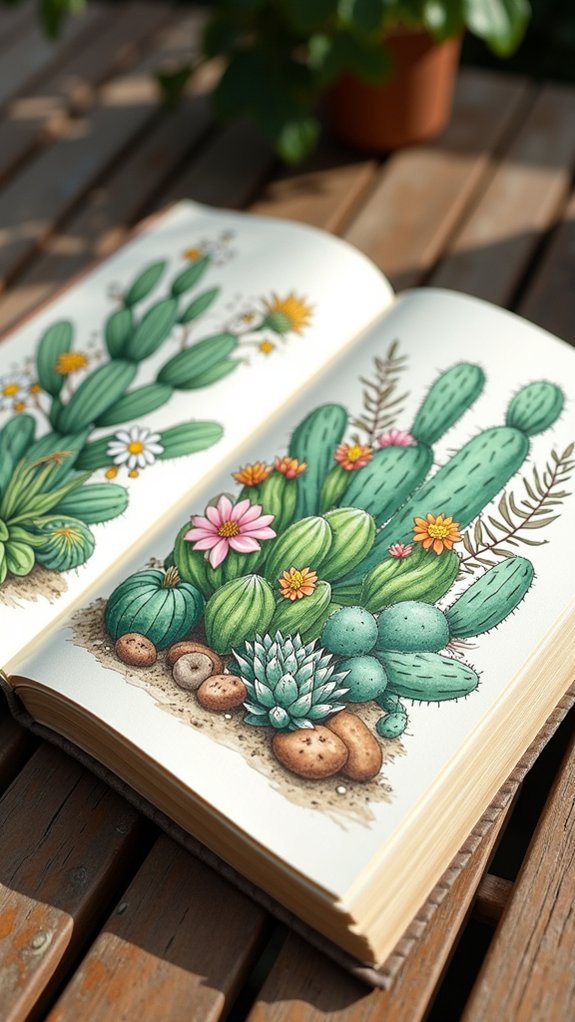
Succulent and cacti illustrations can start with simple doodles—think blobs, rounds, or even jellybean shapes—before bringing in the wild details like spiky cactus arms or chunky little leaves.
It’s fun to play with crazy textures and patterns for the spikes, and you can give your plants instant personality by sketching out a pot underneath, maybe even adding a goofy face or a zigzag design.
Mixing and matching these shapes, details, and decorations can turn even the tiniest doodle into a showstopper that makes any sketchbook page pop.
Simple Succulent Shape Doodles
A sketchbook bursts to life when filled with playful, quirky doodles of succulents and cacti. Drawing these cute plants is almost like inventing your own little ecosystem!
To capture a world of succulent varieties, start with basic shapes—think circles, ovals, or rectangles. These act as the “potatoes” of the desert garden, strong and simple. Use neat doodle techniques to create leaves by adding smaller shapes around the main body, then decorate those leaves or cactus arms with rough lines or peppy dots for plant textures that pop.
Here are three steps for lively succulent shape doodles:
- Sketch basic geometric shapes for succulent bodies.
- Add patterns—lines, dots, and curves—to boost texture.
- Mix up sizes and colors, layering shades for a lively group.
Cactus Spikes and Details
Spikes bring cacti to life, turning those doughy green blobs into wild, spiky characters with real personality. Drawing cactus spikes is seriously fun—just add short, straight lines or sharp little triangles to the surface, and watch your cactus varieties transform.
Try switching up your spike patterns: some cacti rock super-long, dramatic spikes while others look like they’ve just rolled out of bed with tiny, messy bristles. Changing spike lengths and angles can make your doodle look more realistic, like it really belongs in a harsh desert scenery.
Add shading and experiment with different greens and sandy browns for that authentic, sunbaked look. Don’t forget the succulent cousins—swap spikes for thick, rounded leaves stacked on top of each other, for extra texture and depth!
Pot and Decoration Ideas
Once the cactus has its funky spikes and lively texture, it’s time for the best part—giving those cool plants their very own pots and accessories. This is where the magic happens, turning a simple sketch into a burst of personality.
With so many options for pot patterns, decorative textures, and whimsical designs, your plants can be as unique as you want. Think polka-dotted pots, striped mugs, or even a tiny face peeking out from a clay bowl. Don’t forget to add little splashes of color and even a flower or two.
Here are some ideas to jazz up your pots:
- Bright stripes or zigzags for bold, funky vibes.
- Dots, swirls, or floral pot patterns for playful texture.
- Whimsical designs like smiling faces or silly mustaches!
Whimsical Clouds and Weather
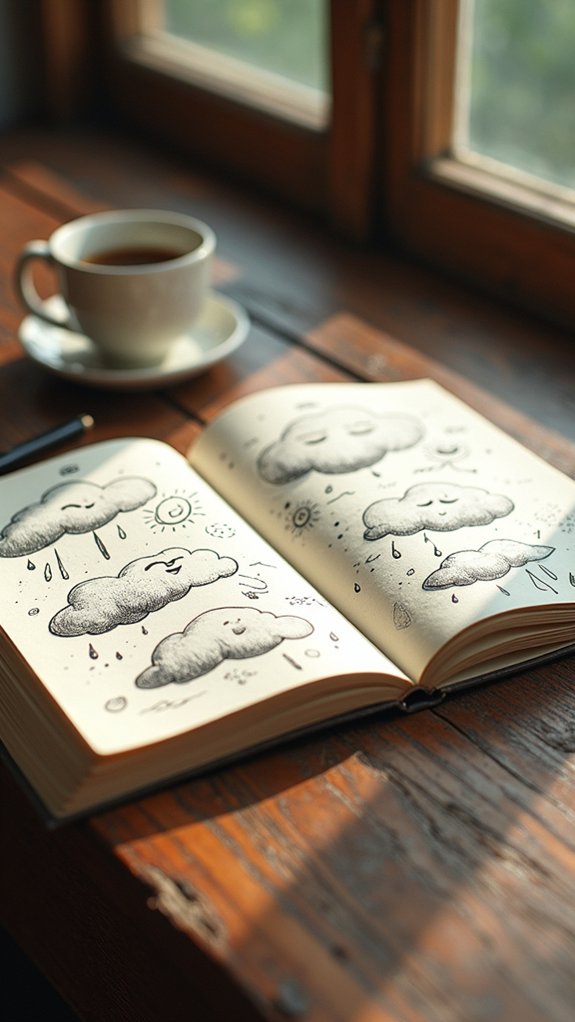
Clouds don’t always have to be serious or plain—sometimes, they’re way more fun with a goofy grin or a sprinkle of rainbow magic. When sketching, artists bring out cloud personalities by giving them big, silly smiles or adding quirky, cartoon eyes.
Want playful weather scenes? Try drawing fluffy clouds with overlapping soft curves in all shapes and sizes, then toss in teardrop-shaped raindrops or wild zigzag lightning bolts. For extra charm, let a sun or rainbow peek out and surprise everyone on the page!
Dreamy colors make everything pop—soft pastels create a gentle mood, but bold streaks bring energy and excitement. These whimsical weather doodles turn ordinary skies into fun-filled parties, where every cloud has its own attitude and story.
Song and Book Cover Lettering
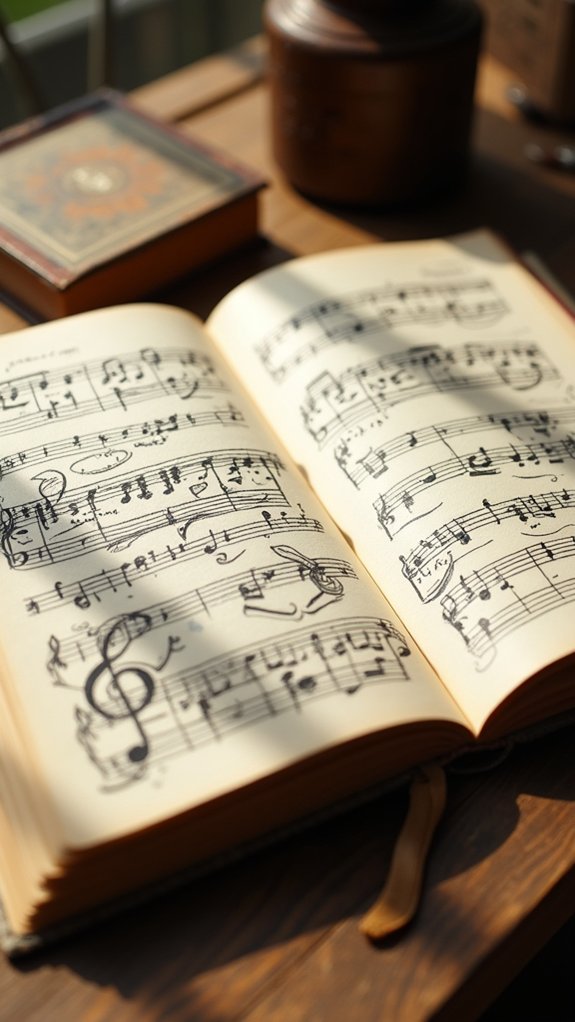
When it comes to song and book cover lettering in your sketchbook, things can get seriously creative—think bold block letters one page, dreamy cursive the next, maybe even both on a wacky pop album title.
Mixing in doodles, bursts of color, or tiny patterns around your lettering can turn a simple word into something that almost jumps off the page.
Pick a theme or mood from your favorite songs or stories, and let it inspire you—just watch how your whole sketchbook page starts to buzz with personality!
Creative Lettering Techniques
Lettering is like giving your words their own personality, especially when it comes to song titles and book covers in a sketchbook.
It’s super cool how the right lettering styles can make a classic rock song pop or a fantasy book title shimmer with magic. Font experimentation turns every letter into a little experiment—try thick, bold lines or curly, wavy letters for a playful feel.
To keep things from getting messy, artists focus on visual balance, so even wild designs look neat and interesting.
Want solid ideas? Here’s a quick list:
- Mix uppercase and lowercase letters with zany font experimentation.
- Add shadows, highlights, or even tiny patterns for dramatic impact.
- Experiment using brush pens or fine liners—the tools totally matter!
Integrating Visual Elements
Sometimes, a sketchbook page just screams for something more than plain words—adding cool visual elements to song and book cover lettering can take everything to the next level.
There’s so much excitement in playing around with lettering styles. One minute, you’re crafting bold, blocky letters like a rock concert poster; the next, you’re doodling delicate, twisty fonts inspired by your favorite fantasy novel.
Pull typography inspiration from album covers, classic books, or even memes (hey, whatever sparks joy). Throw in decorative embellishments—like doodled shadows, cartoonish outlines, or glittery swirls—and suddenly, titles practically leap off the page!
Patterns and background textures add even more fun. Do your letters look like they might start singing? Or maybe solve a mystery? That’s visual magic.
Theme and Mood Inspiration
As soon as someone flips through their sketchbook and decides to try song or book cover lettering, it’s like the whole page turns into a mini stage for drama, suspense, or totally wild vibes.
Diving into typography experiments lets artists capture the mood of their favorite tunes or novels, just by mixing up lettering styles and bold color palettes. It’s way more exciting than just scribbling words.
Adding flourishes, funky sizes, and cool textures makes the page pop and keeps things interesting.
Here are three ways to make theme and mood shine in song and book cover lettering:
- Test out unexpected color palettes based on the overall vibe.
- Experiment with a mix of flowing, sharp, or chunky lettering styles.
- Sprinkle in mini illustrations or graphic doodles around your words.
Bullet Journal Icons
Tiny doodles can totally change the vibe of a bullet journal, turning plain lists into pages that actually make you want to stay organized. That’s where bullet journal icons come in—they’re like tiny heroes with big jobs!
Picture a star marking your super-important homework, or a circle showing an after-school event. With a bit of icon design inspiration, even the dullest page wakes up.
Some people go for minimalist icon styles, like just a thin circle or a dash, while others love seasonal icon ideas—themed little leaves, pumpkins, or snowflakes next to September or December dates.
Keeping icons consistent, maybe all outlined with the same pen or filled in with similar colors, gives a neat look. Don’t be afraid to invent your own!
Sketchnote Moments
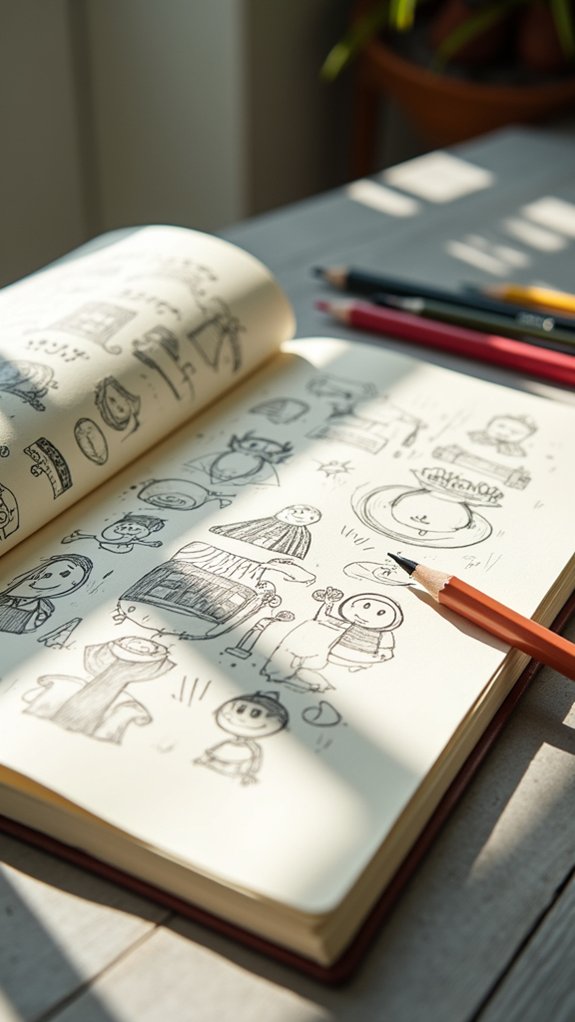
Even if regular note-taking feels like watching paint dry, sketchnoting flips the script and makes information way more exciting.
Sketchnote techniques mix words, visuals, and doodles to turn boring lectures or videos into epic pages of visual storytelling. Instead of just writing facts, sketchnoters add symbols, fun hand-lettered text, and little sketches—all tailored to what stands out most.
With creative prompts to jumpstart ideas, each page becomes uniquely personal. Not only does this method make notes easier to remember, but it also gives sketchbook fans a chance to experiment and have fun.
Here are 3 ways to boost your sketchnote game:
- Use colors and bold lines to highlight big ideas.
- Add quirky icons for key concepts.
- Try layout tricks from Sketchnote Army resources.
Abstract Doodle Studies
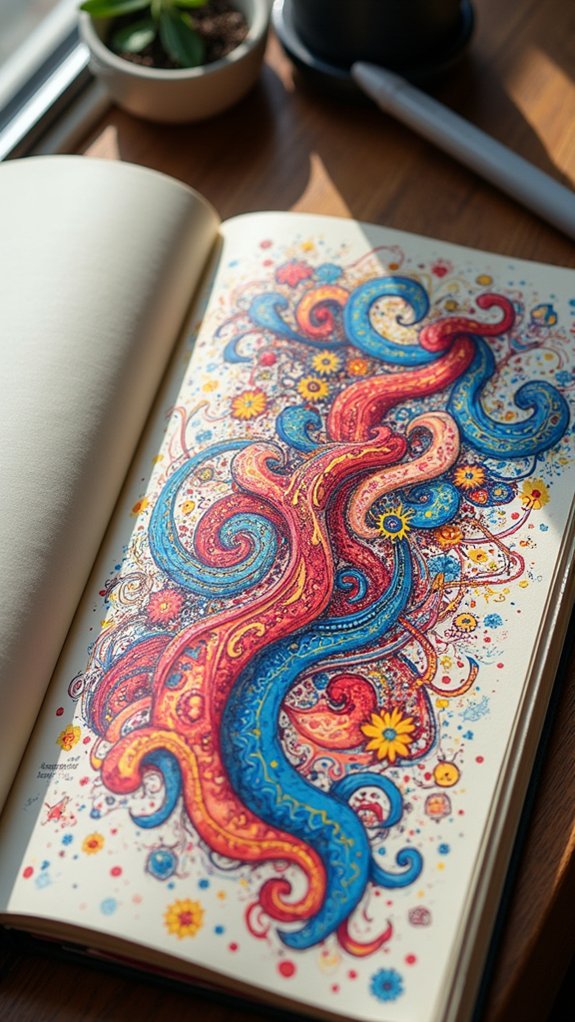
Abstract doodle studies are like the wild side of sketchbooking—rules go out the window and imagination takes the wheel. With abstract exploration techniques, artists let loose, playing with shapes, lines, and wild splashes of color, without worrying about what things are supposed to “be.” Spontaneous creativity exercises like drawing random swirls, zigzags, or even just wacky blobs transform pages into a playground for the mind. Visual texture experimentation makes things pop—add some marker gradients, watery ink washes, or thick, chunky lines for extra flair.
| Technique | How It Feels |
|---|---|
| Swirling lines | Meditative and calming |
| Random shapes | Surprising, funny, unexpected |
| Color layering | Rich, deep, visually exciting |
| Playing with line thickness | Adds drama, emphasizes movement |
Every page can be a surprise party!
Expressive Faces and Emotions
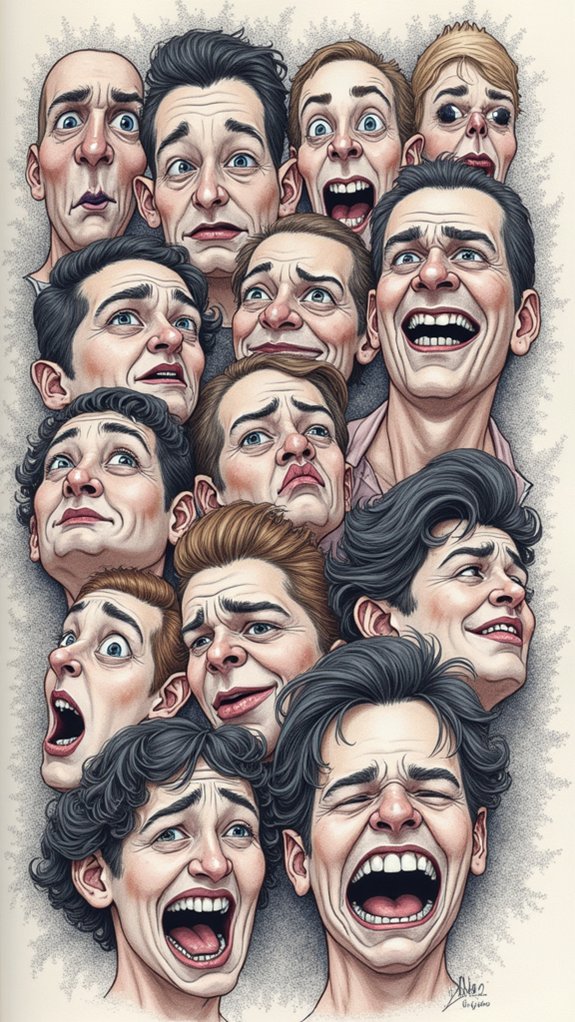
- Change up eyes, mouths, or eyebrows for different emotions.
- Add fun accessories for extra character flair.
- Play with color palettes to boost the mood.
Frequently Asked Questions
How to Fill up Sketchbook Pages?
To fill up sketchbook pages, one may explore various creative techniques, experiment with different sketching styles, and focus on effective page organization. Drawing inspiration from surroundings or integrating patterns and mixed media often enhances visual interest and creative flow.
What to Draw 100 Ideas?
When considering what to draw, individuals might explore whimsical creatures, abstract patterns, and nature scenes among 100 creative ideas. Including portraits, still lifes, urban environments, and imaginative composites can further expand possibilities and spark artistic exploration.
How to Doodle in Sketchbook?
Approaching the question of how to doodle in a sketchbook, one can explore doodle techniques, various sketchbook styles, and creative prompts. These methods encourage artistic expression, relaxation, and inventiveness, allowing spontaneous creativity to flourish on each page.
What’s the Coolest Thing to Draw?
When considering what’s the coolest thing to draw, many artists gravitate toward fantasy creatures for imaginative storytelling, urban environments for dynamic architectural detail, or abstract patterns that allow freedom of expression and creativity through unique shapes and forms.
Conclusion
So, with these 20 sketchbook doodle ideas, anyone can turn a blank page into something awesome. Art doesn’t have to be serious—sometimes squiggly lines and messy faces are exactly what’s needed. Whether a sketchbook is for fun, practice, or just to pass time during math class (shh, don’t tell!), each doodle here can spark creativity. Remember, even superstars started with simple drawings. Why not grab a pen and see where your imagination goes next?

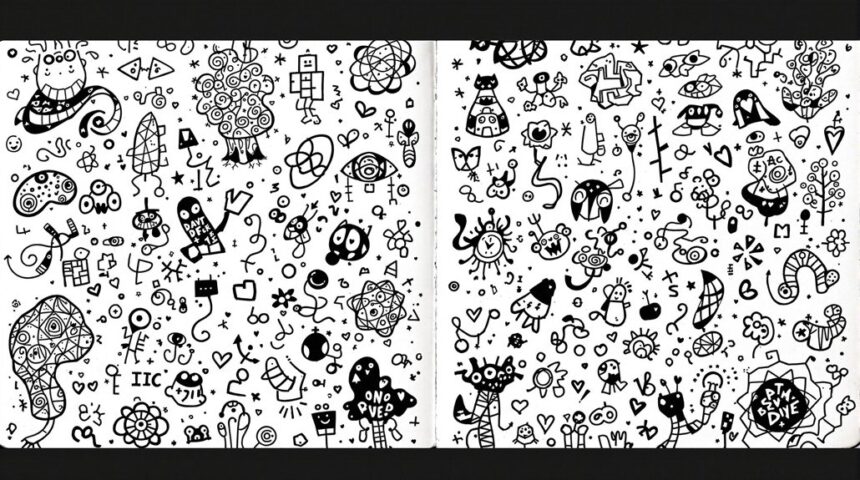
Leave a Reply